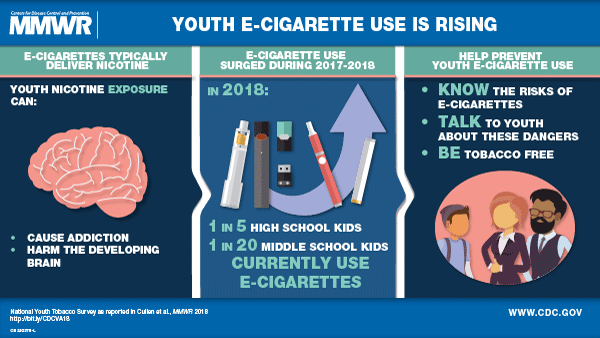Increase in Teen Vaping Raises Concerns
The Food and Drug Administration (FDA) late last year new released new research showing that more than 3.6 million middle and high school students used e-cigarettes in 2018, a significant increase from 2017. More than one in five high school seniors (21 percent) used e-cigarettes, nearly double the number in 2017 (11 percent).
Younger teens are also increasingly using e-cigarettes, also called vaping. The percentage of 10th-graders vaping doubled from 8 percent to 16 percent in the past year and the percentage of 8th-grade students vaping increased from 3.5 percent to 6.1 percent. The estimates are based on a representative sample of more than 13,000 youth nationwide. Many young people report experimenting with e-cigarettes for a host of reasons, including curiosity, appealing flavors, easy access and use as well as the perception that they are a healthier alternative to cigarettes.
 Vaping involves the use of electronic cigarettes to inhale vapor created from a liquid heated up inside a device. The devices rely on batteries to power heating elements that create the vapor. JUUL vaping devices, the most popular devices, look much like a USB drive.
Vaping involves the use of electronic cigarettes to inhale vapor created from a liquid heated up inside a device. The devices rely on batteries to power heating elements that create the vapor. JUUL vaping devices, the most popular devices, look much like a USB drive.
E-cigarettes have been marketed as a safer alternative to regular cigarettes and they contain fewer chemicals than regular cigarettes. But e-cigarettes still carry health risks. Most e-cigarette liquids contain nicotine, a highly addictive drug. Vaping products carry prominent nicotine warnings.
In addition, studies have showing that the adolescent brain is extremely sensitive to the effects of nicotine, including interfering with memory and attention processing. And some research has linked the use of e-cigarettes among youth to later transitioning to using regular cigarettes.

Particularly troubling is the finding from the FDA research that many teens may be unaware they are consuming nicotine. About one in four teens claimed they were vaping “just flavoring,” but they may be unaware of the nicotine content.
The FDA has taken action to address concerns about the increase in teen use of e-cigarettes. The latest action was in November of last year when the FDA announced new limits on flavored e-cigarette sales. Flavored e-cigarettes will only be available in stores where there are age restrictions, such as vape and tobacco shops. The limits do not apply to tobacco, menthol and mint products.
FDA Commissioner Scott Gottlieb, M.D., in a Sept. 12, 2018 statement placed a priority on curbing the growth in the use by teens even if that means limiting adult access. "We cannot allow a whole new generation to become addicted to nicotine," Gottlieb said. He also emphasized that no amount of nicotine should be considered safe for the developing brain.
Citing the harmful effects of e-cigarettes, American Academy of Pediatrics President Colleen A. Kraft, M.D., M.B.A., called for even more action from the FDA: “New data released today confirm what pediatricians have long been warning: e-cigarettes are threatening to addict a generation of young people to nicotine. Not only are we seeing a staggering increase in the number of high schoolers who use e-cigarettes, we’re seeing that more and more of them have moved beyond experimentation and are using e-cigarettes almost daily. This should be a call to action for FDA to take immediate, meaningful steps to stop this trend.”
The message for parents and teens is clear: e-cigarettes are not without risk, including highly addictive nicotine and potential harm to the still-developing teen brain.
References
- Cullen KA, et al. Notes from the Field: Use of Electronic Cigarettes and Any Tobacco Product Among Middle and High School Students — United States, 2011–2018. MMWR Morb Mortal Wkly Rep 2018;67:1276–1277.
- American Academy of Pediatrics. Press Release: AAP Statement in Response to New FDA Actions on Flavored Tobacco Products. Nov. 15, 2018.
- National Institute on Drug Abuse. Research Reports: Tobacco, Nicotine, and E-Cigarettes. Accessed Jan. 9, 2019.
